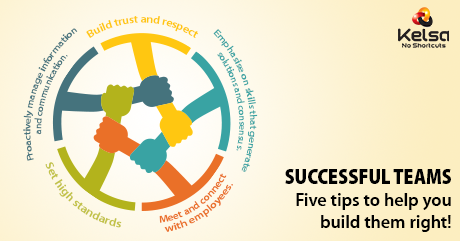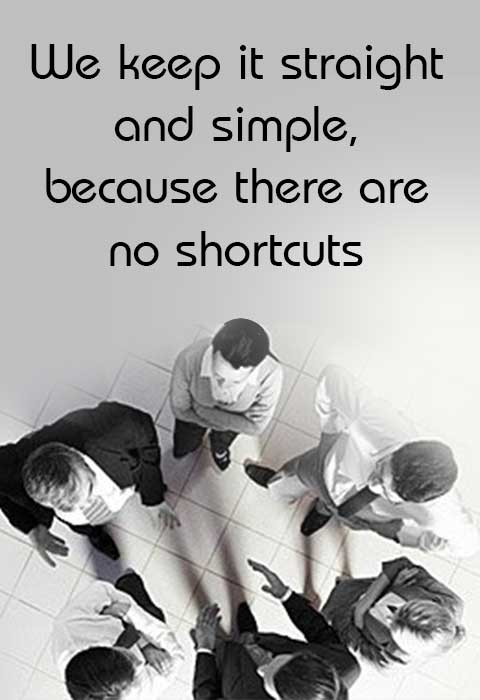Successful teams – Five tips to help you build them right!

Your business can deliver on its goals only when backed by a strong team with a sound work ethic and positive performance culture. Building well integrated and cohesive teams is however not an easy business – leaders will need to recognise that each member plays a valuable role, stay invested in building harmony, respect and competence across the board, and foster an environment that is open, trusting and cohesive.
Here are our top 5 tips to build teams that can work effectively in delivering to organisational goals and stay focused on positive outcomes.
Build trust and respect
Nurturing trust and respect should be top on the agenda for any leader looking to build a team-oriented environment. Leaders who drive steps to build teams based on trust, openness and respect are able to forge better relationships within their teams, and guide them to better standards of work and delivery.
As effective team leaders they are able to ensure that relationships within the team are secure and built on openness and loyalty, as against fear/ power of positions. And their teams are stronger because they operate with trust and integrity, which means thay also navigate the difficult times and sail through rough weather with skill and ease.
Set high standards, for both you and the team
It is important you demand quality work and high standards of delivery from your team, but it is equally important that you demonstrate these values yourself. Establish norms around performance and work ethics very early into the creation of the team unit. This enables the team to drive efficiency and success in any of the tasks they take on. Ensure that norms are set around even the simplest of tasks / directives – for instance, ‘all team members will be punctual for meetings’ or ‘all client inquiries will be responded to within 2-3 hours’. Also, make sure these ground rules and standards are agreed on and set through consensus and everybody commits to them. And importantly, demonstrate your commitment to these standards when you interact with the team both at a group and individual level.
Secondly, take steps to drive a culture of promise and productivity, and ensure your team understands that when good work gets delivered, it is appropriately recognised and rewarded. This way your team will perceive you as being open and reliable, and feel reassured that you always work to delivering on your word. Nothing works as well as setting a good example
Meet and connect with employees
When people know each other, they function better as a team. Being aware of each other’s goals and aspirations, and strengths and weaknesses helps employees to work together and channel their efforts better. So ensure you encourage spaces within your work environment that will allow employees to connect, cooperate and work together to generate solutions.
It is also important to create informal occasions where employees can meet to bounce ideas off each other, discuss challenges and work cohesively to build outcomes. These occasions work well to help employees get together, build warm relationships and connect on an even keel. So take the effort to organise events such as team sports that help build trust, cooperation and camaraderie. It will also offer the team a great way to bring out their creative energies and channel it to a common goal – a highly valued skill in today’s work context.
Proactively manage information and communication
Conflict situations within teams often arise due to lack of clarity on goals related information, imbalance in access or use of information, or communication being managed within closed groups/ silos. In order to minimise any opportunities for conflict, ensure all employees are kept aligned with the goals and priorities of the organisation, and information is easily accessible to all. Equitable access to information fosters trust and transparency within the team, and keeps misunderstandings and conflict at bay.
In addition, ensure all team level information is planned and disseminated in advance. This will allow for healthy communication and sharing of ideas, and encourage everyone to actively participate and build solutions. It is also important to create channels for communication that run across vertical (top to bottom, bottom to top) and horizontal directions (across teams, peer level) where employees feel free to consult, share and exchange information across levels. With open communication channels and adequate access to information, employees feel empowered and work with greater confidence and autonomy.
Emphasise on skills that generate solutions and consensus
Problem solving and solution generation is a reality of our everyday work lives, and teams that have the skills to manage them right are more cohesive and successful. As a leader, encourage your team to think through problems with an open mind and a solution-driven focus. You may have to mediate in some situations, clarify directives or resolve minor conflicts, but reiterate the team goals and let them know that their efforts have to be channelled towards delivering on the common goals.
Also, ensure that each team member is made aware of the importance of their contribution and demonstrate how their deliveries operate together in driving the team goals. Enable them to look for creative approaches while generating solutions and more importantly, work on building consensus at all times. Teams are guided to build consensus, when they are encouraged to share and listen, consider the objectives behind the problem, and plan for solutions and action accordingly. This will also help them to deliver with greater effectiveness and commitment, as they learn to look at the situation objectively, set aside any individual biases and consider solutions that enable team performance.
Successful teams – Five tips to help you build them right!

Your business can deliver on its goals only when backed by a strong team with a sound work ethic and positive performance culture. Building well integrated and cohesive teams is however not an easy business – leaders will need to recognise that each member plays a valuable role, stay invested in building harmony, respect and competence across the board, and foster an environment that is open, trusting and cohesive.
Here are our top 5 tips to build teams that can work effectively in delivering to organisational goals and stay focused on positive outcomes.
Build trust and respect
Nurturing trust and respect should be top on the agenda for any leader looking to build a team-oriented environment. Leaders who drive steps to build teams based on trust, openness and respect are able to forge better relationships within their teams, and guide them to better standards of work and delivery.
As effective team leaders they are able to ensure that relationships within the team are secure and built on openness and loyalty, as against fear/ power of positions. And their teams are stronger because they operate with trust and integrity, which means thay also navigate the difficult times and sail through rough weather with skill and ease.
Set high standards, for both you and the team
It is important you demand quality work and high standards of delivery from your team, but it is equally important that you demonstrate these values yourself. Establish norms around performance and work ethics very early into the creation of the team unit. This enables the team to drive efficiency and success in any of the tasks they take on. Ensure that norms are set around even the simplest of tasks / directives – for instance, ‘all team members will be punctual for meetings’ or ‘all client inquiries will be responded to within 2-3 hours’. Also, make sure these ground rules and standards are agreed on and set through consensus and everybody commits to them. And importantly, demonstrate your commitment to these standards when you interact with the team both at a group and individual level.
Secondly, take steps to drive a culture of promise and productivity, and ensure your team understands that when good work gets delivered, it is appropriately recognised and rewarded. This way your team will perceive you as being open and reliable, and feel reassured that you always work to delivering on your word. Nothing works as well as setting a good example
Meet and connect with employees
When people know each other, they function better as a team. Being aware of each other’s goals and aspirations, and strengths and weaknesses helps employees to work together and channel their efforts better. So ensure you encourage spaces within your work environment that will allow employees to connect, cooperate and work together to generate solutions.
It is also important to create informal occasions where employees can meet to bounce ideas off each other, discuss challenges and work cohesively to build outcomes. These occasions work well to help employees get together, build warm relationships and connect on an even keel. So take the effort to organise events such as team sports that help build trust, cooperation and camaraderie. It will also offer the team a great way to bring out their creative energies and channel it to a common goal – a highly valued skill in today’s work context.
Proactively manage information and communication
Conflict situations within teams often arise due to lack of clarity on goals related information, imbalance in access or use of information, or communication being managed within closed groups/ silos. In order to minimise any opportunities for conflict, ensure all employees are kept aligned with the goals and priorities of the organisation, and information is easily accessible to all. Equitable access to information fosters trust and transparency within the team, and keeps misunderstandings and conflict at bay.
In addition, ensure all team level information is planned and disseminated in advance. This will allow for healthy communication and sharing of ideas, and encourage everyone to actively participate and build solutions. It is also important to create channels for communication that run across vertical (top to bottom, bottom to top) and horizontal directions (across teams, peer level) where employees feel free to consult, share and exchange information across levels. With open communication channels and adequate access to information, employees feel empowered and work with greater confidence and autonomy.
Emphasise on skills that generate solutions and consensus
Problem solving and solution generation is a reality of our everyday work lives, and teams that have the skills to manage them right are more cohesive and successful. As a leader, encourage your team to think through problems with an open mind and a solution-driven focus. You may have to mediate in some situations, clarify directives or resolve minor conflicts, but reiterate the team goals and let them know that their efforts have to be channelled towards delivering on the common goals.
Also, ensure that each team member is made aware of the importance of their contribution and demonstrate how their deliveries operate together in driving the team goals. Enable them to look for creative approaches while generating solutions and more importantly, work on building consensus at all times. Teams are guided to build consensus, when they are encouraged to share and listen, consider the objectives behind the problem, and plan for solutions and action accordingly. This will also help them to deliver with greater effectiveness and commitment, as they learn to look at the situation objectively, set aside any individual biases and consider solutions that enable team performance.




